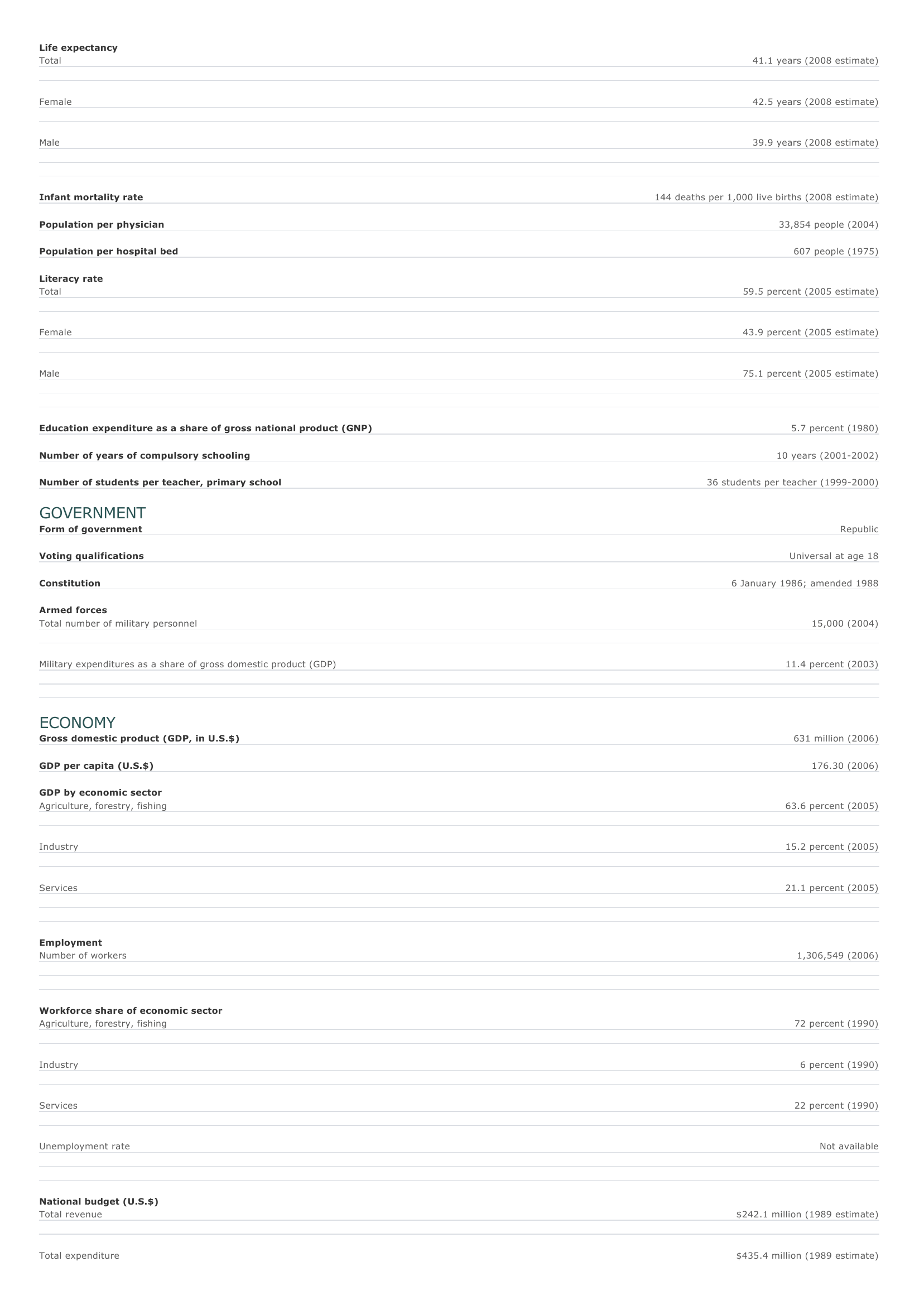Liberia Facts and Figures. BASIC FACTS Official name Capital Area Republic of Liberia Monrovia 99,067 sq km 38,250 sq mi PEOPLE Population 3,334,587 (2008 estimate) Population growth Population growth rate 3.66 percent (2008 estimate) Projected population in 2025 4,753,240 (2025 estimate) Projected population in 2050 7,091,537 (2050 estimate) Population density 35 persons per sq km (2008 estimate) 90 persons per sq mi (2008 estimate) Urban/rural distribution Share urban 48 percent (2005 estimate) Share rural 52 percent (2005 estimate) Largest cities, with population Monrovia 572,000 (2003 estimate) Ethnic groups Indigenous African ethnic groups (Bassa, Gio, Kpelle, Kru) Americo-Liberians (descendants of repatriated slaves) 95 percent 5 percent Languages English (official) 20 percent Mande, Kru-Bassa, other 80 percent Religious affiliations Indigenous beliefs 43 percent Muslim 16 percent Christian 29 percent Protestant 14 percent Roman Catholic Other Christians Nonreligious O ther HEALTH AND EDUCATION 5 percent 10 percent 2 percent 10 percent Life expectancy Total 41.1 years (2008 estimate) Female 42.5 years (2008 estimate) Male 39.9 years (2008 estimate) Infant mortality rate Population per physician Population per hospital bed 144 deaths per 1,000 live births (2008 estimate) 33,854 people (2004) 607 people (1975) Literacy rate Total 59.5 percent (2005 estimate) Female 43.9 percent (2005 estimate) Male 75.1 percent (2005 estimate) Education expenditure as a share of gross national product (GNP) Number of years of compulsory schooling Number of students per teacher, primary school 5.7 percent (1980) 10 years (2001-2002) 36 students per teacher (1999-2000) GOVERNMENT Form of government Republic Voting qualifications Universal at age 18 Constitution 6 January 1986; amended 1988 Armed forces Total number of military personnel Military expenditures as a share of gross domestic product (GDP) 15,000 (2004) 11.4 percent (2003) ECONOMY Gross domestic product (GDP, in U.S.$) GDP per capita (U.S.$) 631 million (2006) 176.30 (2006) GDP by economic sector Agriculture, forestry, fishing 63.6 percent (2005) I ndustry 15.2 percent (2005) Services 21.1 percent (2005) Employment Number of workers 1,306,549 (2006) Workforce share of economic sector Agriculture, forestry, fishing 72 percent (1990) I ndustry 6 percent (1990) Services 22 percent (1990) Unemployment rate Not available National budget (U.S.$) Total revenue $242.1 million (1989 estimate) Total expenditure $435.4 million (1989 estimate) Monetary unit 1 Liberian dollar (L$), consisting of 100 cents Major trade partners for exports Germany, Indonesia, Greece, Poland, and Italy Major trade partners for imports France, South Korea, Japan, Singapore, and Germany ENERGY, COMMUNICATIONS, AND TRANSPORTATION Electricity production Electricity from thermal sources 100 percent (2003 estimate) Electricity from hydroelectric sources 0 percent (2003 estimate) Electricity from nuclear sources 0 percent (2003 estimate) Electricity from geothermal, solar, and wind sources 0 percent (2003 estimate) Number of radios per 1,000 people 329 (1997) Number of telephones per 1,000 people 2 (2002) Number of televisions per 1,000 people 26 (2000 estimate) Number of Internet hosts per 10,000 people 0 (2000) Daily newspaper circulation per 1,000 people 15 (1996) Number of motor vehicles per 1,000 people 15 (1997) Paved road as a share of total roads 6 percent (1999) SOURCES Basic Facts and People sections Area data are from the statistical bureaus of individual countries. Population, population growth rate, and population projections are from the United States Census Bureau, International Programs Center, International Data Base (IDB) (www.census.gov). Urban and rural population data are from the Food and Agriculture Organization (FAO) of the United Nations (UN), FAOSTAT database (www.fao.org). Largest cities population data and political divisions data are from the statistical bureaus of individual countries. Ethnic divisions and religion data are largely from the latest Central Intelligence Agency (CIA) World Factbook and from various country censuses and reports. Language data are largely from the Ethnologue, Languages of the World, Summer Institute of Linguistics International (www.sil.org). Health and Education section Life expectancy and infant mortality data are from the United States Census Bureau, International Programs Center, International database (IDB) (www.census.gov). Population per physician and population per hospital bed data are from the World Health Organization (WHO) (www.who.int). Education data are from the United Nations Educational, Scientific and Cultural Organization (UNESCO) database (www.unesco.org). Government section Government, independence, legislature, constitution, highest court, and voting qualifications data are largely from various government Web sites, the latest Europa World Yearbook, and the latest Central Intelligence Agency (CIA) World Factbook. The armed forces data is from Military Balance. Economy section Gross domestic product (GDP), GDP per capita, GDP by economic sectors, employment, and national budget data are from the World Bank database (www.worldbank.org). Monetary unit, agriculture, mining, manufacturing, exports, imports, and major trade partner information is from the statistical bureaus of individual countries, latest Europa World Yearbook, and various United Nations and International Monetary Fund (IMF) publications. Energy, Communication, and Transportation section Electricity information is from the Energy Information Administration (EIA) database (www.eia.doe.gov). Radio, telephone, television, and newspaper information is from the United Nations Educational, Scientific and Cultural Organization (UNESCO) database (www.unesco.org). Internet hosts, motor vehicles, and road data are from the World Bank database (www.worldbank.org). Note Figures may not total 100 percent due to rounding. Microsoft ® Encarta ® 2009. © 1993-2008 Microsoft Corporation. All rights reserved.



